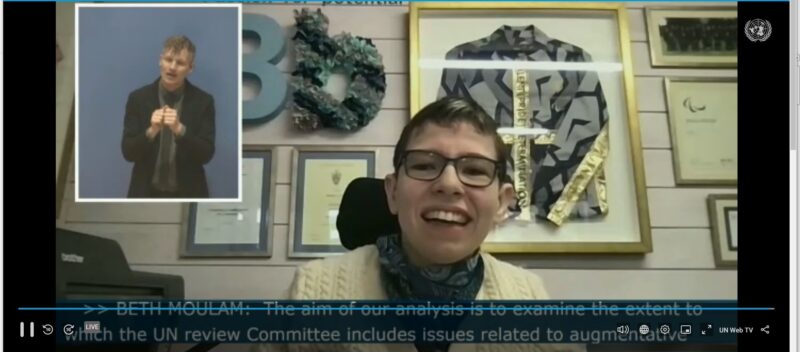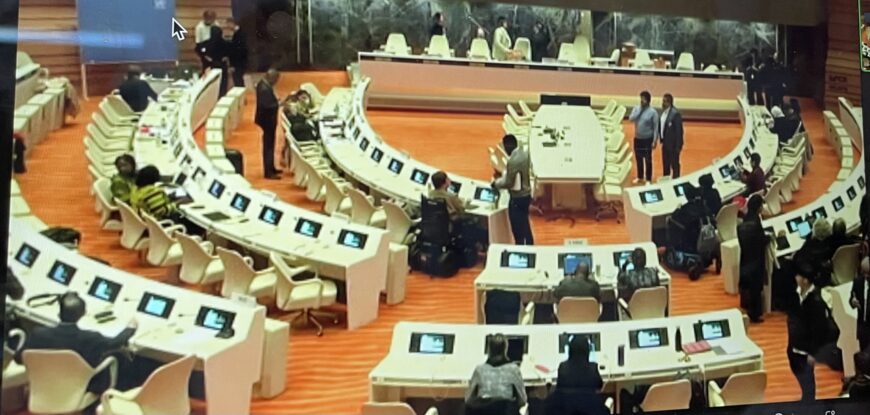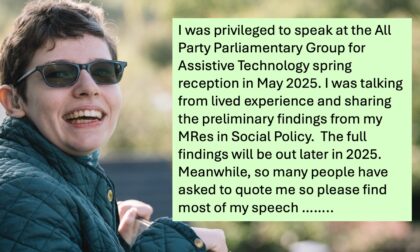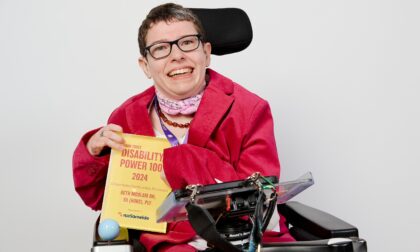On Monday 6 March 2023, Jacob Matthew (Australia) and I had the opportunity to address the 288h UNCRPD committee on communication rights. We were privileged to once more be representing the International Communication Rights Alliance (ICRA). I’ve always believed what gets measured gets done, so I think what we were sharing was important.
ICRA aims
A key aim of ICRA is to evaluate the extent to which the UNCRPD is having a positive impact on the lives of people with communication disabilities in signatory countries.
The work of ICRA
Building on our report to the CRPD committee in August 2022 ICRA has worked on analysing the concluding statements provided by signatory countries in their four yearly reports. This analysis was specifically related to Article 21 with reference to the definitions in Article 2. (Freedom of expression and AAC, see below).

What gets measured gets done – ICRA asked the question:
If these issues are not highlighted in concluding statements, what would motivate signatory countries to take action to improve access to, and knowledge about augmentative and alternative forms of communication in their countries?
Thematic analysis of concluding statements
A thematic analysis was conducted from a sample of twenty-two countries randomly selected. This included at least two countries from each of the four income levels, based on Gross National Income per capita in the previous year, as defined by the World Bank.
Fifteen themes were identified. These are:
- Standards.
- Laws.
- Availability of accessible forms of communication.
- Consultation with the sector e.g., the Deaf community.
- Resources and training.
- Recognition of sign languages as an official language.
- Reference to Augmentative and Alternative Communication.
- Access to software and technologies.
- Accessible websites.
- Translation of the Convention on the Rights of Persons with Disabilities into accessible formats.
- Supporting parents.
- Allocation of funding to accessibility.
- Accessible public services.
- Live Media.
- Teacher Education.
Lack of focus on skills and knowledge of communication partners
Although reference is made to communication supports including Alternative and Augmentative Communication, there is minimal focus on the requirement for skills and knowledge of communication partners. Reference to Alternative and Augmentative Communication modes usually refers to the manner in which information is provided rather than human interaction. These all-important human interactions are fundamental to the quality of civic life and include those with bus drivers, bank staff, shop assistants, and librarians just as a few examples. There are many approaches and strategies these staff can be taught to optimise positive interactions with people with communication needs.
The need for standardised reporting (what gets measured gets done)
In conclusion, ICRA is suggesting the need to increase reporting on actions, or lack of action, to address communication rights. So, in my words, if we address reporting then hopefully what gets measured gets done.
The wording of the full 6 minute ICRA presentation on 6th March 2023 to the UNCRPD committee is below:
“Hello, my name is Jacob Matthew. And I’m Beth Moulam. On behalf of the International Communication Rights Alliance, we would like to thank this UN committee for agreeing to hear an update on our work.
We are pleased to let you know that a number of our members are now engaging with the organisations in their home country who write the citizens reports to the CRPD committee. Through this work we hope to increase reporting on actions or lack of action to address communication rights.
A key aim of the International Communication Rights Alliance is to evaluate the extent to which the UNCRPD is having a positive impact on the lives of people with communication disability in the signatory countries.
As a first step, we are working on analysing the concluding statements provided by the UN Committee to signatory countries in response to the four yearly reports submitted. Concluding statements provide us with consistently presented data in response to the reviews of the complex reports submitted by different countries. We have chosen to analyse concluding statements related to Article 21 with reference to the definitions in Article 2.
The aim of our analysis is to examine the extent to which the UN review committee includes issues related to augmentative and alternative communication and the right to accessible interpersonal communication, in concluding statements. We ask the question: If these issues are not highlighted in concluding statements, what would motivate signatory countries to take action to improve access to, and knowledge about augmentative and alternative forms of communication in their countries?
A thematic analysis was conducted on the most recent concluding statements based on the state and civil reports where available. A sample of twenty-two countries were randomly selected with at least two countries from each of the four income levels, based on Gross National Income per capita in the previous year, as defined by the World Bank.
Fifteen themes were identified. These are:
- Standards
- Laws
- Availability of accessible forms of communication
- Consultation with the sector e.g., the Deaf community
- Resources and training
- Recognition of sign languages as an official language
- Reference to Augmentative and Alternative Communication
- Access to software and technologies
- Accessible websites
- Translation of the Convention on the Rights of Persons with Disabilities into accessible formats
- Supporting parents
- Allocation of funding to accessibility
- Accessible public services
- Live Media
- Teacher Education.
In conclusion, although reference is made to communication supports including Alternative and Augmentative Communication, there is minimal focus on the requirement for skills and knowledge of communication partners. Reference to Alternative and Augmentative Communication modes usually refers to the manner in which information is provided rather than human interaction. These all important human interactions are fundamental to quality of civic life. These interactions include those with bus drivers, bank staff, shop assistants, and librarians just as a few examples. There are many approaches and strategies these staff can be taught to optimise positive interactions with people with communication needs.
We are suggesting the need to increase reporting on actions or lack of action to address communication rights. Thank you for your time and consideration of our presentation.”
ICRA’s initial findings
This was a follow-on presentation to the one Jacob and I made, on behalf of ICRA, to the 27th UNCRPD committee in August 2022. You can find the first presentation here,
Notes:
Founder members of ICRA are the International Society of Augmentative and Alternative Communication (ISAAC), Deafblind International (DbI) and the International Council for Education of People with Visual Impairment (ICEVI).
Article 21 says ‘States Parties shall take all appropriate measures to ensure that persons with disabilities can exercise the right to freedom of expression and opinion, including the freedom to seek, receive and impart information and ideas on an equal basis with others and through all forms of communication of their choice, as defined in article 2 of the present Convention, including by:
- Providing information intended for the general public to persons with disabilities in accessible formats and technologies appropriate to different kinds of disabilities in a timely manner and without additional cost;
- Accepting and facilitating the use of sign languages, Braille, augmentative and alternative communication, and all other accessible means, modes and formats of communication of their choice by persons with disabilities in official interactions;…….’





If you found this interesting or
helpful please feel free to share.